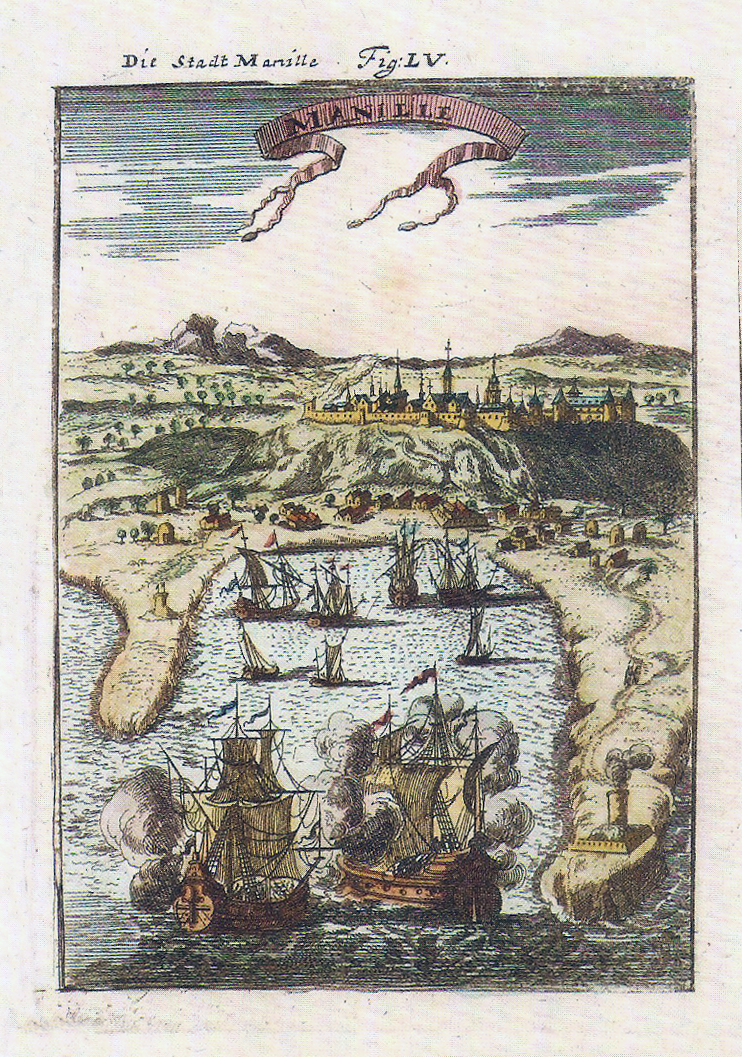Hi Intramuros
In the middle of Manila, there is Intramuros. It's also called the Walled City for obvious reasons, it's encompassed by a wall. The wall was built during the Spanish Era, when the Philippines was colonized by Spain. The places outside the walls are named Extramuros.
A portrait of "Intramuros" Manila in 1684 by Alain Mallet Source

Fort Santiago

This is a citadel inside Intramuros and is one of the main attractions here. This is where Rizal Shrine is located - a museum dedicated to our national hero Jose Rizal.

What you can see above is the entrance to Fort Santiago. Also, before you can reach the entrance, you will have to cross a bridge over a canal pictured below.

The original facade of Fort Santiago in 1880. The front edifice was destroyed by the earthquake of July 1880.
Source
Inside Fort Santiago
Here you'll see Rizal Shrine and also a statue of him.

There are some ruins too that will remind you that these places were made as shelters for wars that happened in Manila.

They've also recorded the steps that Rizal made on his way to his prison inside the now Rizal Shrine.

There's also this cross that serves as a marking for the final resting place of hundreds of Filipinos and Americans who were victims of atrocities during the last days of February 1945.

Baluarte de San Diego
Here's the signage in the entrance of Baluarte de San Diego. It's one of the places we've visited while in the tour. There aren't many places in Manila like this so I'm really amazed how a structure like this was able to survive world wars and civil wars that raged through Manila.

This is the oldest stone fort in Manila - it was actually built in 1586. You've read that right, that's a very long time ago, more than 400 years old already. It has been through many wars and was actually destroyed a few times, then renovated, and was recently excavated in the 80s to become a tourist attraction here in Manila.
After entering the gates you can stay and chill in the gardens. There are places where you can sit in the hall. Though not in this photo.

There are some interesting old things you can see here as well, and take pictures with, just like this cannon. We took a lot of photos of each other posing beside this cannon here. It's actually pretty cool seeing something like this. Like a blast from the past.

There are staircases that lead to the top of this place, just like the one below, the infrastructures are very old since they are hundreds of years old already. You really have to be careful with each step you make when ascending the steps.

Now, here's a view from the top of the same staircase that we've climbed. Those railings were just added after the renovation/excavation of the site. You can actually see how the architecture was built from this view. It seems all those steps where a piece of stone/cement that was stacked on top of each other forming a 'fan'.

I'll also share a view at the top after climbing, there's a wide space up top, like a garden.

We're also able to see the gardens below from where we're at, at the top:

The main attraction inside the Baluarte is its bastioned fort. It's made up of 3 circular walls.
The first circle has an inner diameter of 8 metres and a wall thickness of 1.41 metres. It has a total height of 5.75 metres. Also, its inner and outer sides were plastered in pink terra cotta. The second circle has a diameter of 21 metres with a wall thickness of 0.90 metres. Its total height is 6.15 metres. The interior surface of the second circle was in terra-cotta finish. The flooring of both circles were made of brick tiles. The third circle has a height of 8.55 metres with a diameter of 32 metres and a wall thickness of 3 metres (9.8 ft). It is composed of 11 chambers. Although it is constructed with adobe walls, it has no direct relation to the first 2 circles. It was constructed earlier than the remaining circles.
This place looks amazing. My photos aren't enough to show it. It's actually bigger than how it looks from my shots.

It is prohibited to go down, since it's dangerous, if you walk on top of those walls there's a chance that you'll fall (those are pretty high wall) since there are no railings in the middle.

Here's a bonus nice-looking aerial shot I found from the web:
Source

Relevant Resources:
- Intramuros - Wikipedia
- Fort Santiago - Wikipedia
- Baluarte de San Diego - Wikipedia
- Baluarte de San Diego Aerial Shots - YouTube
Thanks for reading!
Did you enjoy your tour? There are other interesting places and things you can see inside Intramuros. It will take a few blog posts to show every one of those to you, but I will have to make a few trips back to the place as well to take photographs and learn more about those places and things. Till next time!


Nice photos. I have visited Intramuros but have not done a historical tour yet. Still lots of things to discover there. 😊
Thanks! Yes, there's tons to visit.
Wow, that's cool. Thanks.
Thank you. :)